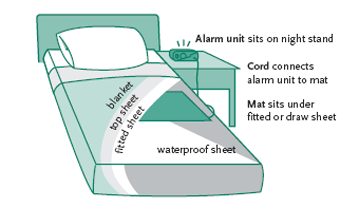Your Cart is Empty
Free Shipping on ALL alarms!
And on all orders of $35 or more *Continental US only
Free Shipping on ALL alarms!
And on all orders of $35 or more *Continental US only
Bell-and-pad is a term used to describe the original type of bedwetting alarm developed more than 50 years ago. The use of this term has persisted in medical, psychological and lay literature and has evolved to describe any type of device that senses moisture and alerts the user through a signal (usually sound) that wetting is occurring.

Like other technology, bedwetting alarms have become more advanced, safer and more efficient over the years. The original “bell-and pad” was simply a mesh or wire unit placed under the sleeping child that was connected to a sound unit. When wetting occurred, the electrical circuit was completed and the unit sounded.
Now, there are numerous models of bedwetting alarms on the market. The two pad type alarm models available today, Wet-Call and Malem Bedside, consist of a safe and comfortable pad which is positioned under the child, sensing moisture and sounding in response to wetness. The Wet-Call is a basic model that sounds when the pad is wet. The Malem Bedside is the top-of-the-line model that provides you with the ability to select different sounds, record your own sounds/voice and has additional accessories available. Both are effective at sensing moisture.
A common concern of users of pad type alarms, however, is that their child moves in their sleep and misses the pad completely. For this reason, the newer bedwetting alarms have evolved into a small, lightweight wearable unit that moves with the child and detects moisture no matter what the sleeping position may be. The Malem auditory, Malem Ultimate and Rodger Wireless are all popular wearable bedwetting alarms. The Bedwetting Store carries a wide range of products, so you can easily find the type of “bell-and-pad” that best suits your particular needs.
Additional information that will help you:
Bedwetting alarms are essential in the treatment of bedwetting. Studies indicate a 60-80% long-term cure rate when used correctly. For a child who has bedwetting, once the bladder is full, instead of waking to go to the bathroom or "holding it" as the non-bedwetting child does, the bladder releases all of the urine into the bed. No one knows exactly why this occurs in some children and not in others. Certainly factors such as deep sleep, small bladder capacity, increased nighttime urine production, constipation and food sensitivities play a part in bedwetting. It seems that these children's nervous systems do not respond to the full bladder-that they are "wired differently". In the child with bedwetting, the brain has to learn what the appropriate response to a full bladder is. This is where the bedwetting alarm is useful.
A bedwetting (enuresis) alarm is a device that emits an auditory and/or tactile sensation in response to wetness. When the child wets, the alarm makes a loud noise to alert the child and his/her parents that wetting is occurring. In theory, the child hears or feels this and learns to get out of bed and empty their urine into the toilet. Gradually, over several months, the child learns to respond to the feeling of a full bladder by going to the bathroom before the alarm goes off. This is a type of behavioral conditioning. It differs from arbitrarily setting an alarm clock to go off at a certain time or by the parents waking the child when they are up. The best type of conditioning is in response to the child's full bladder and urination, which will vary in time from night to night.
Since bedwetting alarms are a mainstay in the treatment of bedwetting, it's an easy first step that most parents can take. No prescription is necessary and children over 6 years can learn to respond.